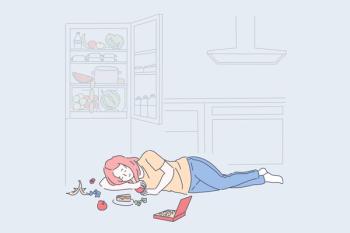
Orthorexia Nervosa: Disease That Masquerades as Health
In the case of orthorexic thinking, clinicians, patients, and their loved ones are bombarded by the same cultural tropes about our bodies and their relationship with the environment in which we live.
When you turn on a television, surf the Internet, or eavesdrop on fellow subway riders, you inevitably hear a constant drumbeat of worry about weight. As the average American gets heavier, images of beauty are becoming increasingly emaciated. The ideal body stretches further out of reach and the difference between who we are and who we want to become seems to loom ever larger. This discrepancy contributes to a perfect storm of thwarted perfectionism and self-hatred that fuels eating disorders.
It’s no wonder that eating disorders are on the rise and are less limited to groups typically associated with them (eg, young and affluent white women).1,2 We see more middle-aged women, adult men, young children, and even the elderly presenting with symptoms of eating disorders. In addition to those whose eating pathology is easily identified (eg, those with frank symptoms of restricting, binging, and purging), we are increasingly seeing people with preoccupations with food and body that can masquerade as a form of health.
One such form of subclinical eating disorders is orthorexia, a term coined by Dr Steven Bratman,3 meaning a compulsion to eat “correctly.” What constitutes “correct eating” varies among individuals. For some, it means eating only organic foods; for others, certain foods-such as those containing gluten, dairy, or any animal-based products-are forbidden; in other cases, curious principles are applied, such as eating what prehistoric humans are imagined to have eaten. Therefore, some orthorexics would consider honey a correct alternative to other sweeteners; to others, honey would be damned as an animal-derived product that represents the human oppression of bees (with too much sugar to boot).
Orthorexia is marked by the compulsive and rigid imposition of a set of ideals about what is correct to consume and the distress that ensues when actual eating does not adhere strictly to these ideals. In anorexia, the goal of food restrictions is to lose or to avoid gaining weight, so the focus is directed toward how eating (or exercising or purging) affects the morphology of the body. Orthorexia instead is a preoccupation with ideas of health or other philosophical ideals.
Like patients with other eating disorders, orthorexics have an intense need to exert control through perfectionism, rigidity, and anxiety. They believe that the crux of the problem lies literally in food. If he or she could just have the right food plan, everything would somehow be okay. The orthorexic patient will sometimes explicitly experience his or her decision making as an attempt to control weight, but the stated goal is more often than not an idealized state of health and a transcendence of the toxic conditions that seemingly lurk in every piece of processed food, or food with gluten, fat, sugar, animal products, and so on. Weight control, if it occurs, is secondary to the pursuit of perfect health.
Although many studies confirm that a diet that includes more whole grains and less red meat, salt, and processed foods improves our health, we don’t need to eat perfectly in order to be physically healthy. The orthorexic patient, however, will argue that if it is good to eat well most of the time, it is better to eat well all of the time.
Historical context in clinical treatment
Clinicians may not look out for the problems of orthorexia because we swim in the same “symptom pool” as those who come to us for help. The term symptom pool is from Edward Shorter’s discussion of the history of psychosomatic illness.4 Culture determines symptoms or a set of symptoms and therefore their epidemiology reflects the historical period in which individuals experience them.
No one era has a monopoly on anxiety. The expression of that universal human experience is inextricably linked to the historical era in which it takes place. For example, anxiety at present may commonly manifest as eating disorders, but in earlier periods in history, it may have manifested as hysteria or neurasthenia, or as symptoms of physical paralysis that we now know do not correspond with how the neurological systems in our bodies are wired.
An awareness of history, therefore, is extremely helpful to the clinician. We may not always be able to see the impact of our culture when we’re in the throes of it, but knowing that dearly held beliefs might not stand the test of time can be helpful in giving us some perspective. Maybe we hold these beliefs a bit less dogmatically.
In the case of orthorexic thinking, clinicians, patients, and their loved ones are bombarded by the same cultural tropes about our bodies and their relationship with the environment in which we live. History may later reveal our current cultural milieu as a time in which intense wishes to be in control often manifest in concerns about our bodies. How do we as clinicians separate fact from belief when current wisdom tells us that how we eat has an enormous impact on our health?
What seems fairly obvious may not hold up in the future. Indeed, advances in the study of genetics and epigenetics explode some of our most fondly held beliefs about how much our will actually affects our bodies. On top of that, known cultural considerations make sorting out fact from belief more difficult for clinicians and patients. For example, images of women in visual and print media have become increasingly smaller since the 1980s when curvier bodies were in vogue. Along with the decrease in ideal size has come an increasing tendency to associate slimmer bodies with that seemingly elusive goal of perfect health.
Under the best of circumstances, eating disorders are difficult to conquer. Unlike other common compulsive behaviors like alcohol or drug abuse, patients cannot eliminate food from their lives. Some would argue that foods like simple carbohydrates are equivalent to alcohol in terms of addictive potential, but at the most basic level, all foods break down into sugars that our bodies use to feed their cells. We can spend the rest of our lives never drinking alcohol, but in order to live, we must continue to eat, day in day out, or, like Kafka’s Hunger Artist,5 we die. The treatment of an eating disorder not only requires the alteration of eating behavior but also urgently requires that underlying issues of anxiety and distorted self-image, of perfectionism and unhealthy narcissism, of idealized fantasies about health, be addressed.
To complicate matters, families and friends of patients who have an eating disorder are also products of the culture. It is not uncommon for the beliefs, eating practices, and fears about health of family members to infect our patients in a form of orthorexia-by-proxy. In my practice, I’ve worked with patients whose struggles to eat a variety of foods were thwarted by loved ones; for example:
-A patient whose partner’s unbending veganism forbade the use of the same cooking pots for foods with and foods without animal products
-A patient whose family only eats salad for dinner virtually every night
-Parents who greet adult children with a bowl full of vitamins at meals in lieu of food
-Parents who deprive their children of wheat or sugar even in modest amounts because of their belief in the advantages of low-glycemic or gluten-free diets
These orthorexic beliefs are intended to protect patients’ health, but family members do not see how the rigidity of their own relationship with food and body negatively impacts the more frankly eating disordered identified patient.
In a society whose perspectives on body image are highly unrealistic, some individuals’ views are more distorted than others. Ironically, the idealizing and the pursuit of a perfect state of health may lead us ever further from emotional and physical well being. It is our job as clinicians to help patients step back with us as we find ways to make peace with our bodies-imperfections and all.
References:
References1. Herpertz S, Hagenah U, Vocks S, et al. The diagnosis and treatment of eating disorders. Dtsch Arztebl Int. 2011;108:678-685.
2. Robinson K, Mountford VA, Sperlinger D. Being men with eating disorders: perspectives of male eating disorder service-users. J Health Psychol. 2012;Mar 27[Epub ahead of print].
3. Bratman S, Knight D. Health Food Junkies: Orthorexia Nervosa-Overcoming the Obsession With Healthful Eating. New York: Broadway Books; 2000.
4. Shorter E. From Paralysis to Fatigue: A History of Psychosomatic Illness in the Modern Era. New York: The Free Press; 1992.
5. Kafka F. A Hunger Artist (“Ein Hungerkünstler”). Die Neue Rundschau. 1922.
Newsletter
Receive trusted psychiatric news, expert analysis, and clinical insights — subscribe today to support your practice and your patients.




